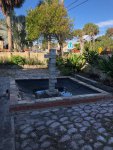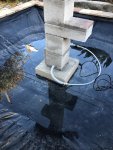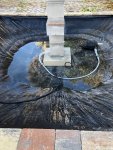- Joined
- Aug 10, 2017
- Messages
- 49
- Reaction score
- 37
- Location
- Daytona Beach, FL
- Hardiness Zone
- 13b
- Country

I recently converted a 10x10 fallow courtyard planter box into an excavated fountain pond by digging out the space to a shallow depth of 12". I then poured a reinforced concrete footing about 36" square and 5-1/2" deep (inside an inlaid 2"x6" wood form) in the center of the dig to support the fountain, and then overlaid a 45 mil PVC liner over the whole excavation. Unfortunately I had to glue two sheets together using an edge-to-edge seam with a 4" wide PVC strip overlapping the joint. I used a commercial PVC glue designed for shower pan liners. I did the gluing in my back yard because of the sheets' size and therefore had a difficult time controlling the preciseness of the bond, but it seemed OK at the time and there you have it.
In retrospect I probably should have laid down a felt liner substrate underneath the PVC liner, but the pit bottom was almost pure sand and I figured any small rocks or sharp objects would simply be pushed down into the sand and not be a puncture problem.
I then laid a 16"x16"x4" solid concrete block over the center of the liner-covered footing, cushioned by two thicknesses of PVC sheeting to protect the liner from the block's sharp edges. The fountain was then constructed piecemeal over the block, consisting in six 8"x8"x8" open-core concrete half blocks and four interspersed 8"x16"x4" open-core half blocks stacked and mortared on top of each other, forming a hollow block tower some 5-1/2 feet tall with 8"x8" "ledges" spiraling around the outside. The center of the column was plumbed for four copper tube spitters emanating from each face of the uppermost block, creating a fountain with four streams of water falling from the tubes and splashing on tile ledges of sequentially increasing heights before dripping down to the surface of the pond (see photos).
After completing and testing the plumbing with a Pond Guy pump and non-pressurized filter intake, I filled the pond and admired my handiwork. Everything was working and looking great for maybe three days - and suddenly, yesterday, the morning of the fourth day, the pond level dropped several inches. Oops.
I decided to wait and watch to see how far the water level would fall. I presumed that wherever the level stabilized, the leak would be somewhere around the liner's perimeter at that level. I am also presuming that the leak would most likely be somewhere along the glued seam. At this point, a day after the leak began, the water level has dropped all the way down to the bottom of the 16x16 fountain base block but is still covering the liner over the concrete footing (photos).
So: Suggestions? In the absence of a better idea, I am going to 1) mark with grease pencil on the PVC around the perimeter where the water level comes to rest 2) drain remaining water and dry entire liner surface 3) let stand for a week or so for water that has leaked under the liner to dissipate into the sand 4) use a thick roller-paintable PVC-compatible sealant product such as Flex Seal over the entire seam as well as the area of liner within and just beyond the marked perimeter, and 5) refill and hope for the best.
I originally purchased about 800 sq ft of this liner ten years ago in hopes of building a pond up in northern Michigan where I used to live. I kept it in storage all these years. When I moved to Florida in February nearly three years ago I decided to bring it with me. The 8x12' sheets were folded into eighths and the cold weather made them stiff as boards. However, once I got them outside in Florida, they became quite pliable and in fact were downright floppy in the 80 degree sun so it was easy to glue, stretch and place them. One thing I did not consider, however, was that once the liner was in place and the pond filled, the weight of the water compacted the sand under it and I noticed there was an edge formed between the sand and the boards enclosing the poured concrete fountain footing - where it was once flush, there was now a 2-4 mm drop from the board edge to the sand - that the liner would've had to stretch to accommodate. In hot weather this would not have been a problem, as warm PVC is quite stretchable. But the water temp was only about 60 degrees, which would have made the liner much less conformable to stretching that amount, and hence more vulnerable to tears. Again, though I don't think this is where my leak is, I probably should have used the recommended felt underlayment.
In retrospect I probably should have laid down a felt liner substrate underneath the PVC liner, but the pit bottom was almost pure sand and I figured any small rocks or sharp objects would simply be pushed down into the sand and not be a puncture problem.
I then laid a 16"x16"x4" solid concrete block over the center of the liner-covered footing, cushioned by two thicknesses of PVC sheeting to protect the liner from the block's sharp edges. The fountain was then constructed piecemeal over the block, consisting in six 8"x8"x8" open-core concrete half blocks and four interspersed 8"x16"x4" open-core half blocks stacked and mortared on top of each other, forming a hollow block tower some 5-1/2 feet tall with 8"x8" "ledges" spiraling around the outside. The center of the column was plumbed for four copper tube spitters emanating from each face of the uppermost block, creating a fountain with four streams of water falling from the tubes and splashing on tile ledges of sequentially increasing heights before dripping down to the surface of the pond (see photos).
After completing and testing the plumbing with a Pond Guy pump and non-pressurized filter intake, I filled the pond and admired my handiwork. Everything was working and looking great for maybe three days - and suddenly, yesterday, the morning of the fourth day, the pond level dropped several inches. Oops.
I decided to wait and watch to see how far the water level would fall. I presumed that wherever the level stabilized, the leak would be somewhere around the liner's perimeter at that level. I am also presuming that the leak would most likely be somewhere along the glued seam. At this point, a day after the leak began, the water level has dropped all the way down to the bottom of the 16x16 fountain base block but is still covering the liner over the concrete footing (photos).
So: Suggestions? In the absence of a better idea, I am going to 1) mark with grease pencil on the PVC around the perimeter where the water level comes to rest 2) drain remaining water and dry entire liner surface 3) let stand for a week or so for water that has leaked under the liner to dissipate into the sand 4) use a thick roller-paintable PVC-compatible sealant product such as Flex Seal over the entire seam as well as the area of liner within and just beyond the marked perimeter, and 5) refill and hope for the best.
I originally purchased about 800 sq ft of this liner ten years ago in hopes of building a pond up in northern Michigan where I used to live. I kept it in storage all these years. When I moved to Florida in February nearly three years ago I decided to bring it with me. The 8x12' sheets were folded into eighths and the cold weather made them stiff as boards. However, once I got them outside in Florida, they became quite pliable and in fact were downright floppy in the 80 degree sun so it was easy to glue, stretch and place them. One thing I did not consider, however, was that once the liner was in place and the pond filled, the weight of the water compacted the sand under it and I noticed there was an edge formed between the sand and the boards enclosing the poured concrete fountain footing - where it was once flush, there was now a 2-4 mm drop from the board edge to the sand - that the liner would've had to stretch to accommodate. In hot weather this would not have been a problem, as warm PVC is quite stretchable. But the water temp was only about 60 degrees, which would have made the liner much less conformable to stretching that amount, and hence more vulnerable to tears. Again, though I don't think this is where my leak is, I probably should have used the recommended felt underlayment.



